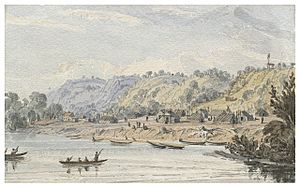Kaposia facts for kids
Kaposia or Kapozha was a village of the Dakota people. It was sometimes called "Little Crow's village." This settlement was located on the east side of the Mississippi River in what is now Saint Paul, Minnesota. The Kaposia group of Mdewakanton Dakota was formed in the late 1700s. It was led by a series of chiefs, all known as Little Crow or "Petit Corbeau." After a big flood in 1826, the village moved to the west side of the river. This new spot was about nine miles south of Fort Snelling.
Contents
History of Kaposia Village
The name Kaposia means "light," "light-footed," or "not carrying much stuff." Many historians think this name meant the people traveled "light." Others believe it referred to the group's skill in the game of lacrosse. They were champions!
Where Was Kaposia Located?
On May 1, 1767, a British explorer named Jonathan Carver attended a meeting of eight Dakota groups. This meeting might have been near where Kaposia village would later be. It was on the eastern side of the river, two miles south of Wakan Tipi in St. Paul.
By 1775, all Mdewakanton groups had set up villages where they lived during the summer. The Kaposia group is thought to have settled in the St. Paul area. Their leader at this time was Chief Cetanwakanmani, who lived from about 1769 to 1833. He was the grandfather of a famous chief named Taoyateduta Little Crow.
American explorer Lieutenant Zebulon Pike visited Kaposia during his trip in 1805–1806. He was trying to find where the Mississippi River started. Historian Edward J. Lettermann believes Kaposia might have been on an "island" at that time. This island was two miles long and up to one mile wide. It was located between Pigs Eye Lake and the Mississippi River. This was its location from 1805 until the early 1820s.
Between 1819 and 1823, Chief Cetanwakanmani moved the village. It moved to what is now downtown St. Paul, near Phalen Creek. After the river flooded in 1826, the Kaposia group moved again. They went to the west side of the Mississippi River. This new spot was north of today's downtown South St. Paul. The village likely moved to the west bank by 1833.
What Was the Economy Like?
Woodworking was a very important skill in Kaposia. The village was famous for making canoes. These canoes were made by hollowing out pine trees using axes and adze tools. The people also carved other items. These included cradles, dishes, spoons, and ladles. The village always had cornfields and vegetable gardens nearby. The women in the group took care of these gardens.
Battle of Kaposia
In 1842, the Ojibwe people attacked the Kaposia camp. This event gave Battle Creek in St. Paul its name.
Land Treaties and Changes
In 1837, Chief Big Thunder Little Crow and other Mdewakanton Dakota leaders signed a treaty with the United States. In this treaty, they gave up their claims to all land east of the Mississippi River.
In 1851, Taoyateduta Little Crow was the first Mdewakanton Dakota leader to sign the Treaty of Mendota with the United States. Because of these land agreements, all Dakota people had to move. They moved to a special area called a reservation. This reservation was on either side of the Minnesota River. The people of Kaposia moved near the Redwood Agency. This place was also known as the Lower Sioux Agency.
Last Days of Kaposia Village
Colonel Seth Eastman painted Kaposia village. His painting showed it below the southern bluffs of Mounds Park.
In 1851, a 23-year-old artist named Frank Blackwell Mayer visited Kaposia. He made many sketches of daily life in the village.
In 1854, Little Crow III visited Washington, D.C. There, he saw artist John Mix Stanley working in his studio. Stanley was finishing a painting of Kaposia. It showed the village with bark and hide lodges, women working, and men carrying canoes to the river. Little Crow was very happy to see it and looked at it for a long time. He pointed out places he knew.
Stanley had also painted a picture of the burial ground near Kaposia. This picture made the chief sad. He looked at the painting of the dead being placed on scaffolds. Then he raised his hands, clasped them, and left the room. No one knew exactly what he was thinking. He likely felt sad that he would never return to his village, which was so clearly shown in Stanley's painting.
Notable People from Kaposia
- Azayamankawin: An entrepreneur from Kaposia, known as "Old Bets."
- Jacob Fahlström: A Methodist preacher who first became a Christian at the Kaposia mission.
- Joseph Renville of Lac qui Parle: A fur trader of mixed heritage, born at Kaposia.
- Snana: A teacher later known as Maggie Brass. She studied at the Kaposia mission school.
- Taoyateduta: The chief of the Kaposia group starting in 1846.
- Wowinape: He grew up in Kaposia village from 1846.
Visiting Kaposia Today
Today, you can find a historic marker for Kaposia. It is along North Concord Street in South St. Paul. Kaposia Park is located where the old settlement used to be. The park is open for everyone to visit.



